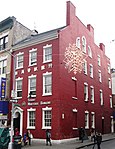Manhattan's Chinatown (simplified Chinese: 曼哈顿华埠; traditional Chinese: 曼哈頓華埠; pinyin: Mànhādùn huábù; Jyutping: Maan6haa1deon6 waa4bou6) is a neighborhood in Lower Manhattan, New York City, bordering the Lower East Side to its east, Little Italy to its north, Civic Center to its south, and Tribeca to its west. With an estimated population of 90,000 to 100,000 people, Chinatown is home to the highest concentration of Chinese people in the Western Hemisphere. Manhattan's Chinatown is also one of the oldest Chinese ethnic enclaves. The Manhattan Chinatown is one of nine Chinatown neighborhoods in New York City, as well as one of twelve in the New York metropolitan area, which contains the largest ethnic Chinese population outside of Asia, comprising an estimated 893,697 uniracial individuals as of 2017.Historically, Chinatown was primarily populated by Cantonese speakers. However, in the 1980s and 1990s, large numbers of Fuzhounese-speaking immigrants also arrived and formed a sub-neighborhood annexed to the eastern portion of Chinatown east of The Bowery, which has become known as Little Fuzhou (小福州) subdivided away from the primarily Cantonese populated original longtime established Chinatown of Manhattan from the proximity of The Bowery going west, known as Little Hong Kong/Guangdong (小粵港). As many Fuzhounese and Cantonese speakers now speak Mandarin—the official language in Mainland China and Taiwan—in addition to their native languages, this has made it more important for Chinatown residents to learn and speak Mandarin. Although now overtaken in size by the rapidly growing Flushing Chinatown (法拉盛華埠) (located in the New York City borough of Queens) and Brooklyn Chinatown (布魯克林華埠), the Manhattan Chinatown remains a dominant cultural force for the Chinese diaspora, as home to the Museum of Chinese in America and as the headquarters of numerous publications based both in the U.S. and China that are geared to overseas Chinese.
Chinatown is part of Manhattan Community District 3, and its primary ZIP Codes are 10013 and 10002. It is patrolled by the 5th Precinct of the New York City Police Department.






